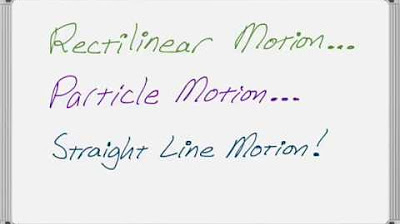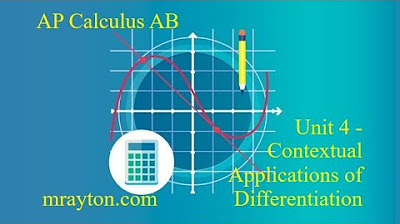Motion and its Types - Part 1 | Don't Memorise
TLDRThe video script introduces the concept of motion, explaining it as the change in position of a body with respect to time. It emphasizes that motion is relative and depends on the observer's perspective. The script provides everyday examples such as vehicles on roads, people walking, and celestial bodies like planets revolving around the Sun to illustrate motion. It also defines 'rectilinear motion' as movement in a straight line, using the example of a car moving on a straight road. The video concludes by highlighting that further types of motion will be explored in subsequent content, piquing the viewer's curiosity.
Takeaways
- 📚 **Definition of Motion**: Motion is defined as the change in position of a body with respect to time.
- 🚗 **Rectilinear Motion**: This is the simplest type of motion where an object moves in a straight line.
- 🌍 **Examples of Motion**: Everyday examples include vehicles on roads, people walking, and birds flying.
- 🌞 **Celestial Motion**: Earth and other planets also exhibit motion as they revolve around the Sun.
- 🔄 **Relative Nature of Motion**: The state of motion is relative to the observer. What appears to be moving to one observer may seem stationary to another.
- 🚉 **Train Example**: People on a train seem to be at rest relative to each other but are in motion relative to an observer on a platform.
- 📏 **Motion and Position**: The key to identifying motion is observing the change in an object's position over time.
- ⏰ **Time Factor**: Time is an essential component in defining motion, as it is the reference for the change in position.
- 🧮 **Different Observers, Different Motions**: The perception of motion can vary depending on the observer's frame of reference.
- 🚦 **Motion in Daily Life**: Motion is a common phenomenon observed in various forms in our daily lives.
- 🔍 **Further Study**: More complex types of motion and the concept of relativity will be explored in higher grades.
- 🎥 **Upcoming Content**: The next video will discuss additional types of motion beyond rectilinear motion.
Q & A
What does Venn do to move the stable from point A to point B?
-Venn pushes the stable in the direction of point B.
What is the term used to describe anything that moves around us?
-Anything that moves around us is said to be in motion.
What are some examples of motion in our daily life?
-Examples of motion in daily life include vehicles moving on the road, people walking across streets, and birds flying in the sky.
What celestial bodies undergo motion as they revolve around the Sun?
-The Earth and other planets undergo motion as they revolve around the Sun.
How can motion be defined in simple terms?
-Motion can be defined as the change in position of a body with time.
What is the simplest type of motion described in the script?
-The simplest type of motion is rectilinear motion, which is motion in a straight line.
What is an example of rectilinear motion mentioned in the script?
-An example of rectilinear motion is a car moving in a straight line on a straight road.
Why do the passengers in the train not consider themselves to be in motion while the train moves?
-For the passengers inside the train, they are at rest relative to each other and the train, so they do not perceive themselves as moving.
What does the observation from the railway platform teach us about motion?
-It teaches us that motion is relative to the observer. Different observers may perceive the same object's motion differently.
What will be discussed in the next video according to the script?
-In the next video, additional types of motion will be discussed.
Why is it important to understand the concept of motion?
-Understanding the concept of motion is important because it helps us describe and analyze the movement of objects in space over time, which is fundamental in physics and everyday observations.
How does the change in position of an object over time relate to motion?
-The change in position of an object over time is the key factor that characterizes motion. If there's a change in position, we say the object is undergoing motion.
Outlines
🚀 Understanding Motion and Rectilinear Motion
The paragraph introduces the concept of motion, explaining that it involves the change in position of an object over time. It uses the example of a table being pushed from point A to point B to illustrate this. The paragraph also touches on the idea that motion is relative, depending on the observer's perspective. It further discusses rectilinear motion, which is motion in a straight line, using the example of a car moving on a straight road. The concept of relative motion is highlighted by contrasting the perspective of a person on a railway platform with that of a passenger inside a moving train.
Mindmap
Keywords
💡Motion
💡Rectilinear Motion
💡Observer
💡
💡Position
💡Time
💡Relative Motion
💡Velocity
💡Acceleration
💡Planetary Motion
💡Daily Life Motion Examples
💡Frame of Reference
Highlights
Venn demonstrates how to move an object from point A to point B by pushing it in the direction of point B.
Motion is defined as the change in position of a body with time.
Rectilinear motion is motion in a straight line, exemplified by a car moving on a straight road.
The concept of relative motion is introduced, where the state of motion is dependent on the observer.
Observers at different positions may perceive the same object's motion differently.
The earth and other planets undergo motion as they revolve around the Sun.
Motion is a common phenomenon observed in everyday life, such as vehicles, people, and birds.
The importance of understanding the position and time factors in defining motion.
The video promises to explore more types of motion in the next installment.
The example of a train and passengers illustrates the relativity of motion.
Different observers can have different perceptions of motion due to their relative positions.
Motion is not absolute but relative to the observer's frame of reference.
The video provides a simple, everyday example to explain the concept of motion.
The transcript uses a conversational tone to make the concept of motion more accessible.
The transcript emphasizes the need to look at what happens to a body when it's in motion.
The video aims to provide a deeper understanding of motion for future study in higher grades.
The transcript outlines the agenda for the video, which includes defining motion and discussing rectilinear motion.
The concept of motion is broken down into its fundamental components: position and time.
Transcripts
Browse More Related Video
5.0 / 5 (0 votes)
Thanks for rating:





